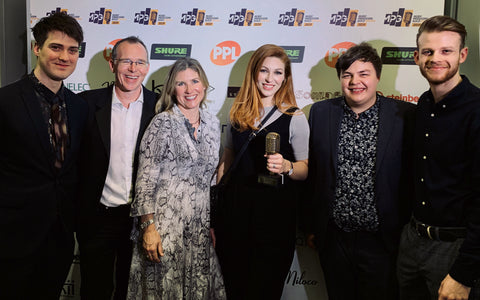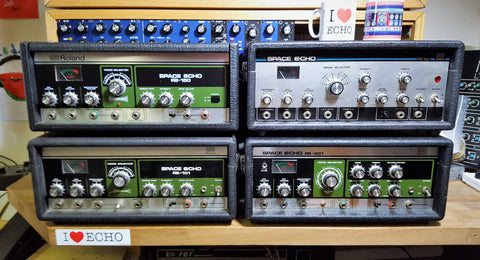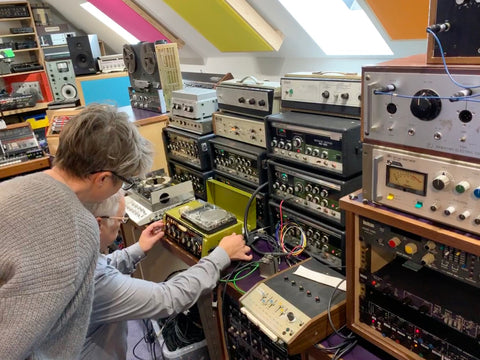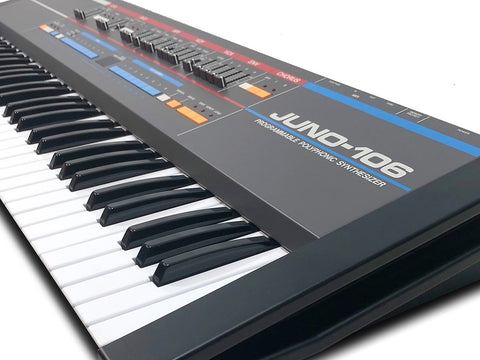Down To Earth: Korg Stage Echo SE-300 & SE-500 by Tony Miln
Feb 01 2018 5 Comments Tags: Gear History, Keio, Korg, Roland, Roland tape echo, Space Echo, Stage Echo, Tape / Disc Echo
Soundgas head honcho, Tony Miln, digs into some of the history and features of superb Korg's tape echoes, and also some useful information if you are asking yourself "Should I get a Korg Stage Echo or a Roland Space Echo?".
Comments are on! Let us know which echo you use and how/why. Interesting tales and useful tips may be used (with credit) in future articles.

Roland’s black, green and silver (and later black and orange) Space/Chorus Echo units are familiar to nearly everyone who’s been involved in music-making over the past four decades - they are iconic and ubiquitous. Korg’s echoes are more down to earth - in livery as well as name. Swapping Space for Stage and jazzy colours for the muted - almost gothic - dark grey/black contemporary to their synths, Korg Stage Echoes are much less common than their cosmic cousins and, as a result, there are many yet to encounter them.
Korg started out as beatbox pioneers Keio, later developing their first MiniKorg synth at the same time as Roland were working on the SH-1000 (the latter securing its place in history as Japan’s first synth in 1973 - Roland had the drop on Korg’s 700 only by a matter of weeks). The MiniKorg’s success spawned a long line of unusual and groundbreaking synths under the Korg banner, many of which are rightly regarded as classics, while some remain comparatively well-kept secrets.
Given Korg’s deserved reputation for innovation, it may come as a surprise to many that the Korg Stage Echo SE-500 was only launched in 1977 - a full four years after Roland’s first Space Echo, the RE-100. Korg was certainly playing catch up when they entered the echo market; the mighty RE-201 had been in production for three years and was proving a very successful and profitable product for Roland.
One advantage of following in Ikutaro Kakehashi’s footsteps was that Korg were able to marry many successful elements of the Space Echo with features that would please both their synthesizer customers as well as guitarists and studio users.

For the synth and studio heads, there was CV control of the delay time - this allows users of Korg’s flexible semi-modular MS series synths (and others with CV out) to get creative with their repeats with suitably freaky results. Guitarists and keyboard players could have fun layering their instrument using the Sound On Sound feature (Brian May anyone?). Mike Battle’s Echoplex EP-2 was the first tape echo to feature Sound On Sound back in 1970; coincidentally, Roland only added SOS to their tape echo range in the same year as the SE-500’s debut with the RE-301 Chorus Echo.
In addition, the SE-500 had a long delay feature with repeats up to a whopping 1500ms - impressive for a tape echo at the time (remaining so to this day). The long delay and three other playback heads could be switched in and out independently or in combination for a range of patterns. The Stage Echo’s compander-based noise reduction system made for a cleaner-sounding tape echo - certainly more HiFi than those that had gone before. The addition of balanced inputs/outputs on XLR sockets reinforced the SE-500’s position as a serious studio machine for the professional user.

The SE-300 launched a year later, in 1978, offering spring reverb and very flexible mixing and routing options between dry/delayed signal and the reverb tank. This was also the year that saw Roland launch their first BBD chip-based analogue echoes (the DC-30 and DC-50), whose maintenance-free reliability and portability were the beginning of the end for tape echoes. Given the fateful timing of their release, it’s hardly surprising that Korg’s Stage Echoes are harder to track down than their celestial Roland cousins, having been produced in much smaller quantities.
However, scarcity is far from the only reason to seek out one of Korg’s Stage Echoes; their alternative approach to Roland’s staple fare offers the discerning echo enthusiast additional menu options to whet the appetite.
They are highly-regarded by those looking for a cleaner, more hifi echo sound than the earlier Space Echoes (while remaining distinct from Roland’s own cleaner-sounding RE-501/SRE-555). Personally, I love the flexible mixing options between on the SE-300: three uncomplicated balance knobs make this machine unique. The controls are:
- Reverb Input Balance - between direct and echo signals
- Echo/Reverb Balance
- Output Balance - between dry and echo/reverb signals
They offer immediate and complete control over the balance of the dry/echo/reverb signals enabling you to position the signal in the soundfield; as gratifying in use as it is simple in concept. If you want to push the repeats further into the distance, add some reverb to the echo signal only; or add reverb to dry/wet signals and adjust the balance to taste. Clumsy to describe in writing, simplicity itself in practice!
So why would I choose a Stage Echo over a Space Echo, and what are the main differences between the Korg and Roland machines? Below I list a few questions that point towards which machine might be most suitable for you.

Do you want a classic delay/reverb that’s been heard on countless recordings from the early seventies onwards?
If yes, you most likely want a Roland RE-201 Space Echo (or if your budget is tighter and you can live without the spring reverb, the RE-101). The RE-150 has no spring reverb and only two replay heads (as opposed to the 201/101’s three), but they have a great sound and are a good option to get the Roland Space Echo sound on a tighter budget.
If you want a classic delay/reverb, but also yearn for Roland Chorus and the sound on sound (but are not looking for classic dub delay patterns), then the Roland RE-301 could be for you. The head spacings are different on the 301 (compared to to the 201), so while dub aficionados may find it less-gratifying, guitarists and keyboard players love the less-common 301. I bought my 301 from Dave Formula of Magazine: it was used on several of their albums (and on the Visage albums) - you can see it behind Dave on the cover of Magazine’s live album, ‘Play’.
Are you looking for a cleaner, more high fidelity sound to your repeats? If you are, then the choice is between the Korg Stage Echoes or a Roland RE-501 Chorus Echo (or SRE-555 which is simply a 501 in rack format). The later Rolands incorporated a noise reduction system (as well as chorus, sound on sound and of course spring reverb) which made them sound a good deal cleaner. I’ve always thought of them as being the Roland Echo to buy if you like the sound of the late seventies or early eighties (a strat through an RE-501 gets you pretty close to the sound of Andy Summers of The Police or David Gilmour on Pink Floyd’s The Wall). I used two very clean 501s in my studio for many years as my main go-to guitar/synth echoes, partially because they worked faultlessly, but also because they seemed to just sound ‘right’ whenever we used them. I’ve latterly grown more fond of RE-201s (and eventually sold my last 501 when I bought Dave’s 301); this is down to just how good they sound when they’re less-worn and well-serviced. The Roland RE-501/SRE-555 and the Korg SE-500 also feature balanced inputs/outputs for studio use.
If you are after a cleaner sound (and chorus/spring reverb aren’t essential), and you also want longer delay times, and the ability to control the delay time via control voltage (CV) from your synth, modular system, or a control pedal, then the Korg SE-500 is your machine. Or for a cleaner sound with spring reverb (but no sound on sound), then you want to try the SE-300 (which is my personal favourite of the two due to the flexible mixing options discussed earlier).
While researching information for writing this piece, I was struck by just how little information there is about Korg’s two fine echo machines. Like some of their contemporary synths, they seem to be for the cognoscenti only. I hope this article helps set the record straight to some extent, and we would welcome any additional information or comment from Stage Echo users.
See our current stock of Korg Stage Echoes now - if we don't have what you need on that page please get in touch as we try to have machines coming through as often as possible.
Comments are on! Let us know which echo you use and how/why. Interesting tales and useful tips may be used (with credit) in future articles.
5 Comments





Korg SE300 here,
I use it for live shows with a customised Great British Spring, stereo EH Phaser and a Tascam TSR8. Basically an analogue studio. I do live dub mixing – people come up too me during a show and say “what’s that thing going round?” (reel to reel)
Anyway the SE300 is perfect for the job and I also use it with my semi modular synth setup.
Need too know about servicing it – any idea?
I love tape echo, I was brought up on it in the recording studios of the Seventies and Eighties as a tape op and then engineer.
Take a 2 track tape recorder with the different tape and line up possibilities, add to this varispeed eq and compression and feedback the signal from the mixing desk and away you go. Having said this there’s none better than a good echoplex. I have owned several over the years. I just bought a serviced EP2 from Tony and now awaiting it’s arrival.. I’ll give you some feed back back back etc
Nice article. Yes its true, there isn’t much info out there about the SE’s. A while ago I made a quick video illustrating the hard-to-get-your-head-around the reverb/echo mix functions: https://www.youtube.com/watch?v=VIds6SknqOg
And the user manuals for these (and many others) are on my website http://www.korganalogue.net/korgother/index.html
Korg SE-300 all the way.
As written in the article, the flexibility to crossfade between the various stages gives it a unique edge.
Plus, if you overdrive the input all “hi-fi”-ness is gone, replaced by a phat saturated but highly musical sound with enhanced harmonic content.
Instant ticket to Lee Perry territory.
Use mine constantly for the last 25 years. Had it thoroughly recapped & works a treat. A lovely sounding machine that easily outperformed all the RE-201s i have encountered so far.
Best thing – it was given to me for free in the early 90s by a friend, owner of big PA/equipment hire company, when they were actually throwing them out as obsolete gear.
But the SE-500 is no slouch, either.
Very complex & long taps may be dialed.
And voltage control of time (“speed”) gives it an experimental edge.
Sneaky shortcut to Frippertronics territory.
Sweet sweet echo,
Twice or thrice had I lov’d thee,. Before I knew thy face or name;. So in a voice, so in a shapeless flame.
I utilize two tape echos in my music meanderings -
Multivox Multiecho MX-201
Roland Chorus Echo RE-501
Each have a special place in my heart, the Multivox was my first – I primarily use it on synth & vocals. It is more free & unpredictable than the Roland – which is where the absolute magic comes from, it’s more ethereal in nature.. this is why I feel it’s more suited for synth & vocals as opposed to guitar – which is what I use the Roland for. The routability of the delay/Echo through the reverb is an awesome feature.
I needed a bit more predictability for guitar & the re-501 fits the bill perfectly. Also spectacular for drum machine. I’d like for it to have more tone shaping for chorus – or more severe oscillation abilities.
When recording I chain them together to get several textures – would love another .. the possibilities are endless it’s the time to do so that gets in the way hahaha
Echo forever
Leave a Comment